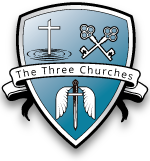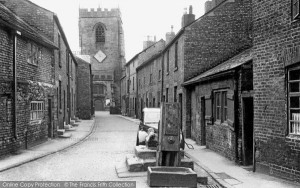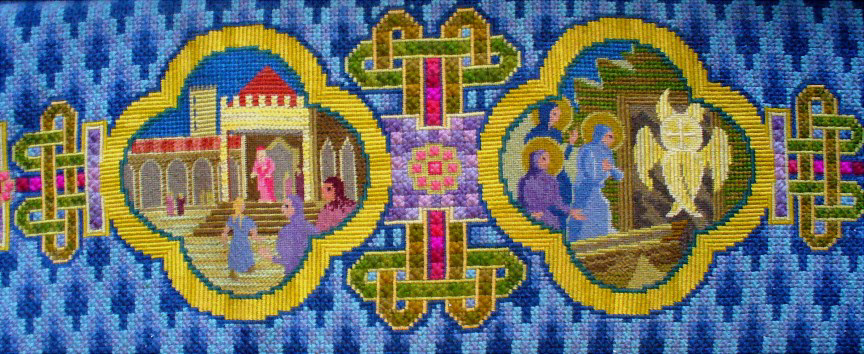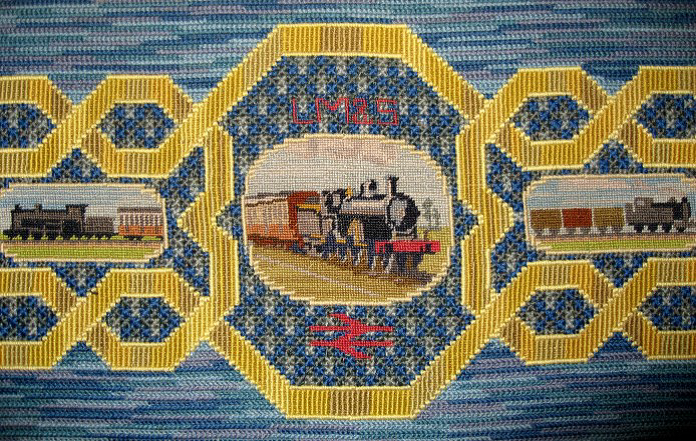Setting of the Church
The parish church of St Michael & All Angels church is situated at the end of Church Street which is off the main road running through the village and is situated next to the 17th century bridge over the river Yarrow.
At the north end of the street stood the village pump (which was removed in the late 20th century) and the base of an ancient preaching cross which could have given the village its name.
The cross is a 20th century restoration.
The village is surrounded by farm land and is situated between the towns of Ormskirk and Preston.
As you walk around the village it is easy to see how the village has built up over the years by the architecture of the houses, and while there was a thriving business community and the Hall within living memory, sadly they have all gone with business sites changing into new housing estates and the Hall was demolished after being left to the Catholic Liverpool Diocese.
Despite this there are still a number of people whose families have lived in the village for a number of generations and are active in the life of the church and the village and are a wonderful source of historical tales about village life.
Most homes in the village are owner occupied with only 100 households receiving social rent, and a lower than the nation average number of people who are receiving unemployment benefits[1].
There is a joint Church of England/Methodist infant/junior church school and a Church of England Academy in the village. While the younger children are mainly from the village the academy has a catchment area which includes a number of villages in the surrounding area.
In the grounds of the church we have a disabled parking area, a choir vestry adjacent to the church and the old village school which is now a village hall which can be rented and used by the community.
The church land continues behind the church and has Bishop Alan Chesters Wood an area with a wide variety of trees including, horse chestnuts and a small leaf lime. A number of the trees have been planted in memory of people from the village who have died.
The area has been developed to be family friendly, with an eco-hut and a verity of play equipment suitable for a wide range of age groups.
It is popular with local families and it’s not unusual during summer for children to have their birthday parties in the wood.
Once a year we hold a ‘Music in the Woods’ festival with local groups providing the entertainment as the community join together to have a picnic and enjoy the music.
Behind the wood is a large grassed area owned by the church which we have transformed from a field rented to a local farmer into a place of natural beauty for the community.
A willing band of volunteers look after the field and it is already turning into a nature conservation area full of wildlife with native wild plants and a small wooded area at the top end of the field.
Both areas of the field have trees ranging in age from young through to trees hundreds of years old which are managed to ensure there will always be mature trees to replace those which will need to be cut down because they have died or been infected with decease.
Both areas contain over 37 varieties of wild flowers[2] and are very popular with walkers and people taking their dogs for a walk. The council are supporting the project by providing specialist advice and funding and they have provided bins for the disposal of dog waste.
There are seats located around the area and a picnic table next to the river.
West of the church is the old Rectory, which is now a privately owned residential nursing home. Once a month we provide volunteers to bring residents from the home to church for a short communion service and once a month we have a communion service at the home to enable those who are unable to go to church to receive communion.
Social History & the History of the Church
While there is no record of how the village received its name a popular explanation is that during the time of Paulinus the first Archbishop of York who died in 644AD, a monk came to the the marshland and stuck his sharp pointed wooden cross into the ground next to the River Yarrow.
There has been a church in Croston since about 1075.
After the Norman conquest the Norman Count Roger of Poitou granted Croston to the Abby of St Martin at Sees.
The Prior and Convent of Lancaster presented the rectors until Edward the Third, when he claimed Lancaster for himself as an alien priory.
Croston remained in the hands of the Crown until Henry VII granted it to his new monastery of Syon near London in 1420.
Croston Parish originally consisted of: – Hoole, Tarleton, Hesketh, with Becconsall, Rufford, Bretherton, Bispham, Mawdesley, Chorley and Ulnes Walton.
Cronological List
| 1390 | The Croston Charter confirmed by Richard II[1] |
| 1500-1530 | Three Chantry chapels founded in the church. |
| 1534 | The reformation. |
| 1541- 1847 | The Parish of Croston belonged to Chester Diocese. |
| 1545 | sees the dissolution of the Chantries. |
| 1642 | Hoole becomes a separate parish. |
| 1660 | Reverend James Hyett at his own expense procured a free schoolhouse in Croston churchyard ‘for the good education of the children of the said parish’. Reverend Hiet ordered that each scholar should pay one shilling at entrance (sixpence if the parents were poor cottagers), that the master should teach the principles of the Christian religion and that he should be allowed to receive 10 scholars for quarterly wages but this should not hinder the teaching of the free scholars. |
| 1662 | In August Reverend James Hyett was expelled for refusing to resume use of the Book of Common Prayer and deprived of the living of Croston by the Act of Uniformity. His feelings against the prayer book were so strong that he left instructions in his will that he was to be buried without it. The next rector Reverend James Pilkington gave permission for the funeral but waived his right to officiate. The service (without the prayer book) was taken by Mr Welch who had also been expelled at Chorley. |
| 1693 | Henry & Isabella Croston’s alms-houses built. |
| 1704 | On the 23rd February George Norris of Croston gifted £26 to Thomas Norres of Croston & Henry Sumner of Mawdesley to be laid out in oaten bread to the poor of Croston attending divine service. |
| 1710 | Vestry minutes dated 15th November “Memorandum it was then agreed by ye Churchwardens & several of ye Parishioners of Croston Parish that ye body of the church up to ye Chancell being in a very ill & very dang’rous manner as to the foundations of ye Pillars fallen in by ye frequent Burying in the Body of the Church and by floods piercing ye earth, and filling up ye Graves. It was concluded and agreed upon that new earth should this year be brought in and ye Flaggs new laid upon new earth & rightly leveled to a due & ????? & suitable hight & be brought as high as can be to ye Flaggs on ye level of ye Flaggs on wch ye Reading Desk & Pulpit stand. Signed Wm. Pilkington, Rector”. |
| 1711 | Vestry minutes dated 31st January 1710 (31st January 2011 in modern terms- parish years ran from 25th March at that time) stated that the work must proceed urgently and any parishioner who failed to bay the levy decreed by the parish to pay for the work would be taken before a ConsistoryCourt. |
| An entry dated 23rd May noted “that Side & North Side of the Church adjoining the Body of the Church be also earthed & flagged as the Body is to be earthed and flagged” It notes that this is dependent on sufficient funds. | |
| 1711 | Vestry minutes and accounts state that Mr Loxam is to be have half a crown a year for looking after the clock and as often as he comes to attend is to have one shilling a day for expenses. |
| 1765 | Ann Master mother of Reverend Robert Master gave £200.00 for the purchase of religious books for the poor of Croston Parish. |
| 1790 | Mr Fearnley a clockmaker from Wigan was sent with a church warden to Lancaster to inspect the new clock for the parish made by Mr Shawe. |
| 1793 | Chorley & Rufford became separate parishes & a private Roman Catholic Chapel was built at the Hall. |
| 1800 | Commission to erect an organ at the west end of the church with a gallery, seats and staircase. |
| 1809 | Jubilee Alms-houses built. |
| 1818 | Savings Bank founded. |
| 1820 | in 1898 the Charity Commissioners’ Report stated “it appears from an entry in 1804 that a sum of £50 arising from the sale of a seat in the church …. Should be lent to the trustees of this school to be laid out in erecting seats in the south aisle … The erection of seven seats …. Amounting to £21. 5s. 8d of the above £50 and the residue was eventually placed in the hands of the Reverend Streynsham Master, who had been elected a trustee and had become Rector of Croston about 1799 …. In 1820 he left England, in consequence of the embarrassed state of his pecuniary affairs which were placed in the hands of the trustees …. Other instance will be hereinafter mentioned in which sums belonging to charities were in Mr Master’s hands at the time of leaving England” |
| 1821 | Tarleton & Hesketh became separate parishes. |
| 1823 | First Methodist Chapel built in Croston. |
| 1827 | Reverend Hiet’s school re-built. |
| 1840 | Bretherton& Mawdesley became separate parishes. |
| 1847- 1926 | The Parish of Croston belonged to Manchester Diocese. |
| 1849 | Liverpool to Preston railway line going through Croston. |
| 1857 | Pugin built Chapel of the Holy Cross at Croston Hall[2] |
| 1862 | Gas Works opened. |
| 1863 | The Croston Relief Fund for weavers unemployed as a result of the American Civil War. |
| American Civil War. | |
| 1866-67 | Galleries removed and the organ moved to the east end of the former north chapel. |
| 1871 | New Boy’s School opened in Highfield Road. |
| 1880 | Commission for the erection of an organ at the west end of the church. |
| 1882 | Present tower clock installed and was dedicated by Augusta Master in memory of her sister Margaret Penelope, who was the third daughter of Reverend Streynsham Master. |
| 1899 | Organ installed by F.H. Browne of Deal in Kent. |
| 1903 | Faculty granted for the stained glass windows in the Lady Chapel in memory of Reverend Oswald Master rector of Croston for 27 years who died on the 15th November 1901. |
| 1909 | Reverend Atherton Gwillym Rawstorne, M.A. consecrated Suffragan Bishop of Whalley. |
| Suffragan Bishop of Whalley. | |
| 1926 to date | The Parish of Croston has belonged to Blackburn Diocese. |
| 1932 | Faculty granted for new stained glass in East Window. Refurbishment of the chancel to the designs of Sir Walter Tapper. Some notes mention that the monogram encaustic tiles in the south aisle are to represent the uniting of the Manor of Croston under the ownership of John Randolphus de Trafford in 1874, who had inherited the Ashton part of the Manor by marriage. |
| 1932 | Croston & District Nursing Association founded. |
| 1934 | Croston Urban District Council disbanded. |
| 1951 | Faculty granted for stained glass windows in memory of Anne Francis Rawsthorne who died in 1938. |
| 1960 | The Bishop Rawstorne C.E. Secondary School founded. |
| 1964 | Croston Hall bequeathed to the R.C. Diocese of Liverpool on the death of Miss Ermyntrude de Trafford. While the chapel remains the hall has been demolished.[3] |
| 1969 | New St Michael’s Junior School building opened & the infants School remodelled. |
| 1972 | The Bishop Rawstorne C.E. Secondary School became a Comprehensive School. |
| 1975 | The Bishop Rawstorne C.E. High School officially dedicated and opened. |
| 1977 | Queens Jubilee Celebrations & the first Untied Coffee Day with the Methodists. |
| 1980 | Second hand grand piano was purchased with a donation from the family of Charles Henry Beard in his memory. |
| 1987 | Old Rectory next to the church sold. |
| 1992/3 | All lighting except the chandeliers were replaced. |
| 2001 | St Michael & All Angels & St John the Baptist, Bretherton, become a United Benefice. |
| 2012 | The Bishop Rawsthorne C.E. School became an Academy. |
| 2014 | St Michael & All Angels & St John the Baptist, Bretherton, St Peter, Mawdesley with Bispham, apply to become a United Benefice. |
| 2015 | January became the United Benefice of Croston, Bretherton & Mawdesley with Bispham. |
| [1]Typed copy displayed on the west wall of the Nave. | |
| [2]The Chapel can be seen from the Croft Field but is no longer used. | |
| [3]Pictures of the hall and Chapel can be seen in the book ‘Traipsing from a Lancashire Toll Bar’ by Betty Gilkes& Stan Pickles. | |
The church keeps a traditional medieval layout, with a chancel at the east end with former chapels on each side of it. Before the Reformation in the 16th Century, all churches in England were Roman Catholic and the layout of the church relates to this tradition of Christian worship.
St Michael’s stands close to the Yarrow, a position which made it vulnerable to damage from flooding and waterlogged ground. The stonework tells a story of centuries of change as testament to those who rebuilt, repaired and adapted the fabric.
The earliest surviving remains are stone features of 13th century origin in the chancel. Otherwise the oldest stonework is probably of 15th century date.Records suggest that a substantial rebuilding occurred in 1577 and many other works are documented, with a succession of repairs in the 18th century. Rebuilding of the roof and other works in 1823, and major restoration in 1866-7 by architect Gordon Hills.
Differences in the stonework and types of window are clues to the changes.
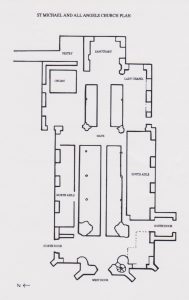
Plan of church prior to the restoration work in 2017
1.4 The Church building in general, in detail and contents
The church is a historical treasure worthy of its original status as the parish church of Chorley and surrounding area.
The church has a fine collection of stained glass windows, monuments and the pews and choir stalls have embroidered cushions and kneelers which were made by members and friends of St Michael & All Angels parish between 1977 & 1992 and was started by Mrs Bruce, the Rector’s wife.
- Jesus in the temple & the angel appearing at the tomb
- Commemorating the Ormskirk –Preston railway line which passes through Croston
